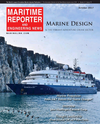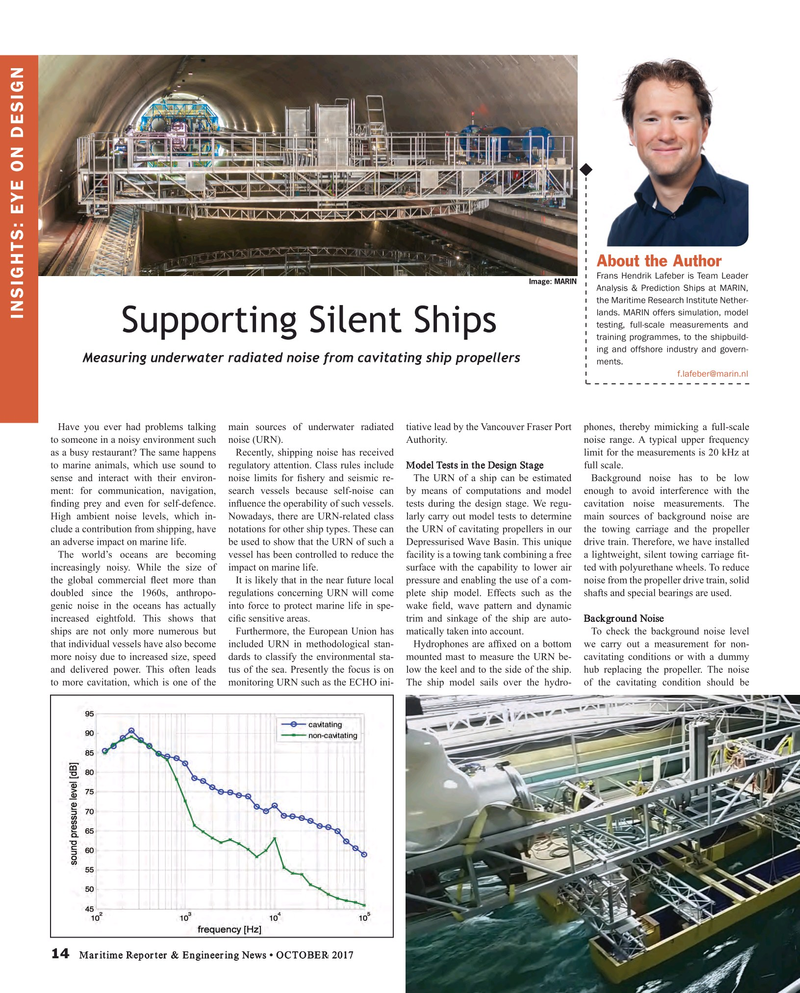
Page 14: of Maritime Reporter Magazine (October 2017)
The Marine Design Annual
Read this page in Pdf, Flash or Html5 edition of October 2017 Maritime Reporter Magazine
About the Author
Frans Hendrik Lafeber is Team Leader
Image: MARIN
Analysis & Prediction Ships at MARIN, the Maritime Research Institute Nether- lands. MARIN offers simulation, model
INSIGHTS: EYE ON DESIGN testing, full-scale measurements and
Supporting Silent Ships training programmes, to the shipbuild- ing and offshore industry and govern-
Measuring underwater radiated noise from cavitating ship propellers ments. [email protected]
Have you ever had problems talking main sources of underwater radiated tiative lead by the Vancouver Fraser Port phones, thereby mimicking a full-scale to someone in a noisy environment such noise (URN). Authority. noise range. A typical upper frequency as a busy restaurant? The same happens Recently, shipping noise has received limit for the measurements is 20 kHz at to marine animals, which use sound to regulatory attention. Class rules include Model Tests in the Design Stage full scale. sense and interact with their environ- noise limits for ? shery and seismic re- The URN of a ship can be estimated Background noise has to be low ment: for communication, navigation, search vessels because self-noise can by means of computations and model enough to avoid interference with the ? nding prey and even for self-defence. in? uence the operability of such vessels. tests during the design stage. We regu- cavitation noise measurements. The
High ambient noise levels, which in- Nowadays, there are URN-related class larly carry out model tests to determine main sources of background noise are clude a contribution from shipping, have notations for other ship types. These can the URN of cavitating propellers in our the towing carriage and the propeller an adverse impact on marine life. be used to show that the URN of such a Depressurised Wave Basin. This unique drive train. Therefore, we have installed
The world’s oceans are becoming vessel has been controlled to reduce the facility is a towing tank combining a free a lightweight, silent towing carriage ? t- increasingly noisy. While the size of impact on marine life. surface with the capability to lower air ted with polyurethane wheels. To reduce the global commercial ? eet more than It is likely that in the near future local pressure and enabling the use of a com- noise from the propeller drive train, solid doubled since the 1960s, anthropo- regulations concerning URN will come plete ship model. Effects such as the shafts and special bearings are used. genic noise in the oceans has actually into force to protect marine life in spe- wake ? eld, wave pattern and dynamic increased eightfold. This shows that ci? c sensitive areas. trim and sinkage of the ship are auto- Background Noise ships are not only more numerous but Furthermore, the European Union has matically taken into account. To check the background noise level that individual vessels have also become included URN in methodological stan- Hydrophones are af? xed on a bottom we carry out a measurement for non- more noisy due to increased size, speed dards to classify the environmental sta- mounted mast to measure the URN be- cavitating conditions or with a dummy and delivered power. This often leads tus of the sea. Presently the focus is on low the keel and to the side of the ship. hub replacing the propeller. The noise to more cavitation, which is one of the monitoring URN such as the ECHO ini- The ship model sails over the hydro- of the cavitating condition should be 14 Maritime Reporter & Engineering News • OCTOBER 2017
MR #10 (10-17).indd 14 MR #10 (10-17).indd 14 10/4/2017 9:10:21 AM10/4/2017 9:10:21 AM

 13
13

 15
15
